Key takeaways:
- The Cobra movement emerged in the late 1940s as a response to traditional art, prioritizing spontaneity and emotional expression.
- It arose post-World War II, seeking healing and social commentary while challenging established art movements.
- Key artists like Asger Jorn, Karel Appel, and Corneille exemplified the movement’s principles through vibrant, expressive works.
- The Cobra movement emphasized collaboration, spontaneity, and the fusion of art with life, influencing contemporary artistic practices.
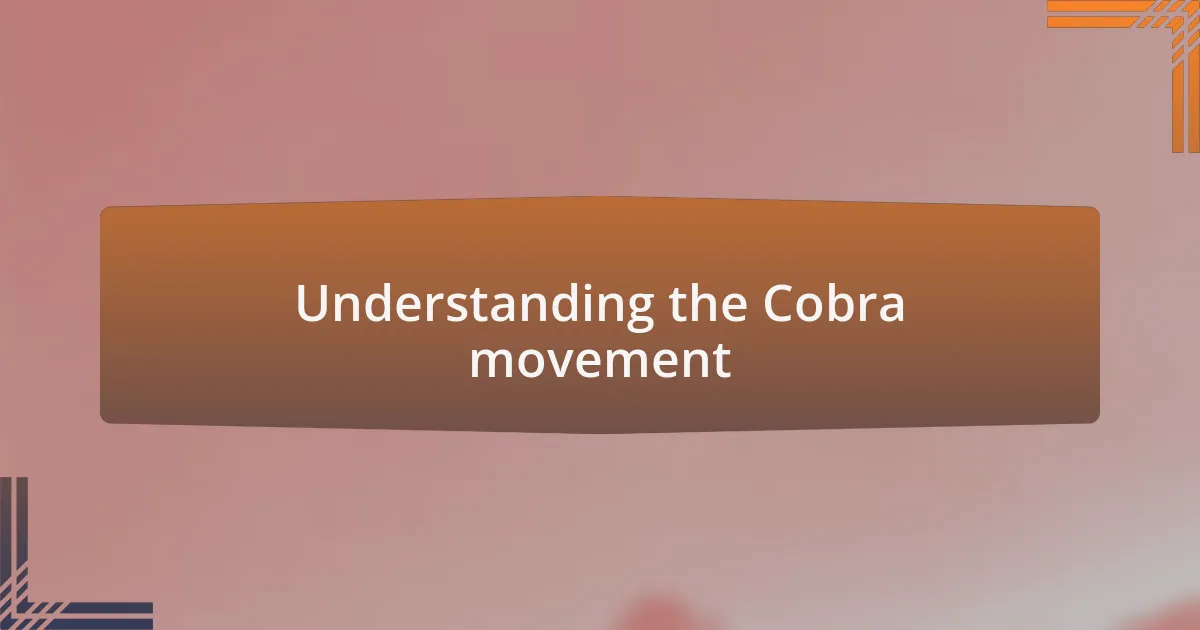
Understanding the Cobra movement
The Cobra movement, named after the capitals of its founding members—Copenhagen, Brussels, and Amsterdam—emerged in the late 1940s as a response to the rigid constraints of traditional art. I vividly remember the first time I encountered a Cobra painting; it was exhilarating to see how the artists embraced spontaneity and raw emotion. How liberating it must have felt for them to break free from established norms and explore their creativity without boundaries.
This group sought to channel the energy of children’s art, prioritizing intuition over technical skill. I often wonder if their rejection of perfection resonates with our current pursuit of authenticity in art. While observing their vibrant color palettes and expressive forms, I felt a deep connection to their philosophy—art as a means of personal expression rather than mere visual representation.
Cobra artists were not just creating art; they were challenging societal norms and advocating for a new world through creative expression. Their work was a protest against the status quo, and the emotion behind each piece was palpable. Have you ever seen a piece of art that stirred something deep within you? That’s precisely what Cobra aimed to achieve—art that provokes thought, elicits feelings, and encourages dialogue about the world we inhabit.
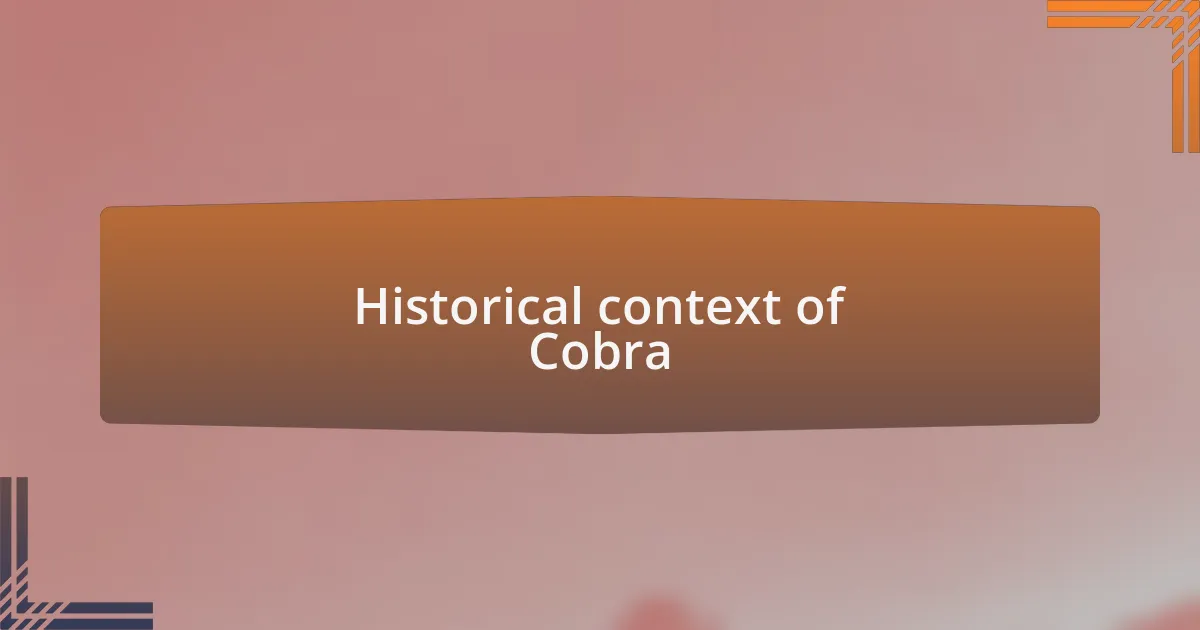
Historical context of Cobra
The Cobra movement arose in the aftermath of World War II, during a time when Europe was grappling with the scars of conflict and the limitations imposed by traditional art. I remember reading about how these artists sought refuge in the liberating expression of their inner feelings, which was a radical departure from the art of the preceding era. Was it not remarkable how they used art as a tool for healing and social commentary, reflecting the tumultuous spirit of their time?
In 1948, the founding of the Cobra group represented a collective desire to forge new paths beyond the confines of established art movements, such as Surrealism and Abstract Expressionism. I often find myself captivated by the idea that these artists were not only creating for themselves but also challenging one another to explore uncharted territories of creativity. Their collaborative spirit and shared vision seemed to ignite an unprecedented energy that still resonates today in contemporary art.
The members believed in the power of collective creativity, seeing themselves as part of a cultural revolution. When I think about their approach, it’s inspiring to realize how they intertwined art with existential freedom, emphasizing a life fully lived. Isn’t it fascinating how their work emerged out of a shared commitment to push against societal constraints, creating an artistic dialogue that transcends mere aesthetics?
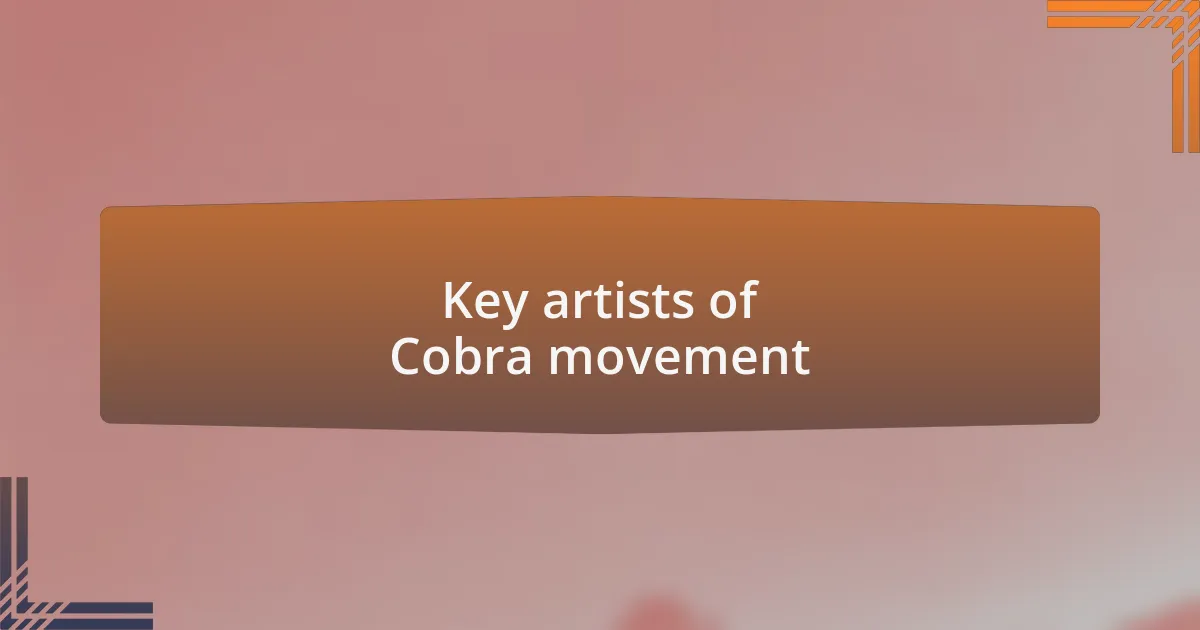
Key artists of Cobra movement
When discussing key artists of the Cobra movement, it’s impossible not to highlight Asger Jorn, whose vibrant and impulsive works truly encapsulate the spirit of the group. I remember the first time I encountered his pieces; it was as if I could feel the raw emotion pulsating from the canvas. Jorn’s ability to blend abstraction with figuration reflects not only his artistic prowess but also his desire to radically challenge conventional norms. How can one not be drawn into the world he created, filled with spontaneity and fervor?
Another significant figure is Karel Appel, whose playful yet chaotic compositions embody the freedom that Cobra artists celebrated. His work often pulsates with color and movement, almost demanding the viewer’s attention. I’ve found myself captivated by the energy in Appel’s paintings, feeling an emotional response that reminds me of childhood creativity—those moments when art wasn’t about rules but about sheer exploration. Isn’t it interesting how his legacy continues to inspire both artists and casual viewers alike?
Lastly, I must mention Corneille, whose imaginative landscapes and use of bold color reveal his deep connection to nature and the subconscious. The joy I felt exploring his work was profound, as if each painting invited me to partake in a dreamlike narrative. His philosophy that art should embrace the spontaneity of life truly resonates with me; doesn’t it remind us all of the inherent beauty in unpredictability and emotional authenticity?
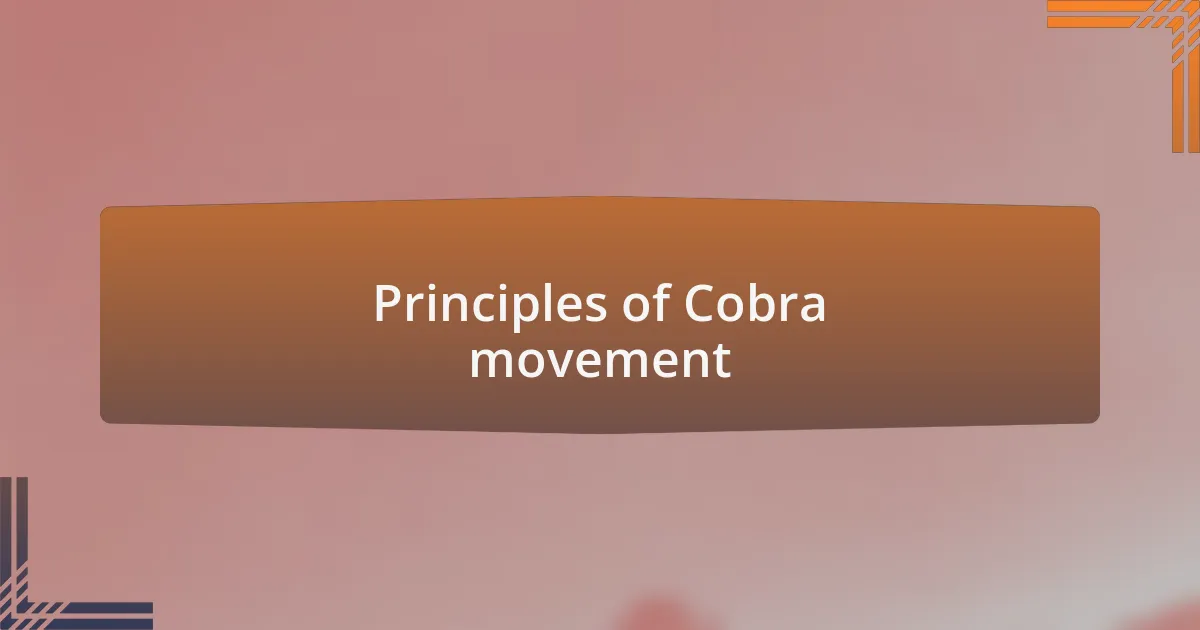
Principles of Cobra movement
The Cobra movement is fundamentally rooted in spontaneity and experimentation, encouraging artists to break free from traditional art techniques. I remember attending an exhibition where the exuberance of improvisation was palpable. It made me think: how liberating it must be to let go of control and embrace the unexpected—much like life itself.
Another principle of Cobra revolves around the fusion of art and life. Artists believed that their creative expressions should reflect their immediate experiences and social realities. Reflecting on my visits to various Cobra art shows, I often found myself pondering how each piece served as a window into the artist’s world, capturing raw emotions and vibrant narratives that felt incredibly real.
Lastly, the Cobra movement championed the idea of collaboration among artists. I once took part in a community art project that mirrored their ethos—a shared canvas where diverse perspectives merged into one artwork. This experience highlighted for me the beauty of collective creativity; it’s fascinating to consider how shared artistic endeavors can lead to unexpected yet profound outcomes, echoing the spirit of Cobra.
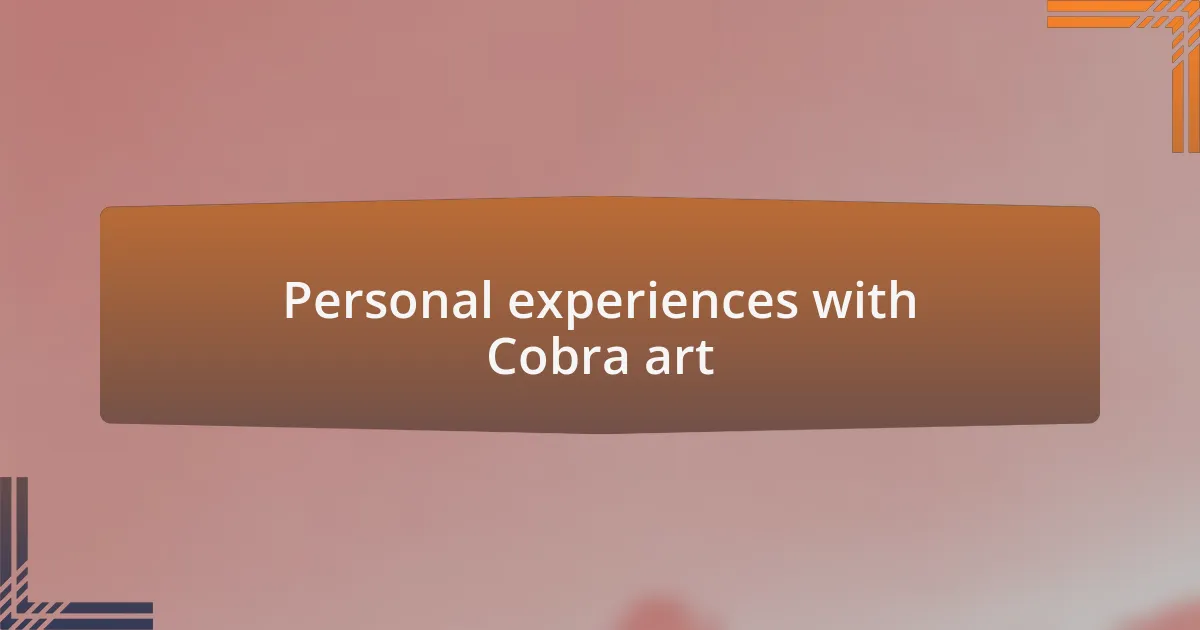
Personal experiences with Cobra art
When I first encountered Cobra art, I remember being struck by its vibrant colors and bold forms. Standing in front of a large canvas that seemed to pulse with energy, I couldn’t help but feel a connection to the artist’s unfiltered emotions. It made me realize how art can transcend words and speak directly to our shared humanity—how often do we overlook that in other forms of expression?
In another instance, I explored a mixed-media installation that incorporated elements of play and chaos, characteristic of Cobra’s spontaneity. It was almost as if the pieces were challenging me to interact and engage, prompting questions about my own artistic limitations. This idea of breaking free from the ordinary resonated deeply with me; isn’t it refreshing to embrace a little chaos in a world that often craves order?
At one memorable exhibition, I stood beside a giant mural created during a live collaboration between several artists. The process unfolded before my eyes, full of laughter and spontaneity. Watching them work together, sharing ideas and techniques, made me reflect on my own experiences in group settings—how do I contribute to a collective vision? The energy was electric, encapsulating the very essence of the Cobra movement and leaving me inspired to seek out similar communal artistic experiences.
Reflection on Cobra’s influence
The Cobra movement has profoundly influenced contemporary art in ways that invite introspection. I often find myself reflecting on the movement’s emphasis on spontaneity and playfulness, which challenges the rigid structures artists often feel bound by. Do you remember the last time you stepped out of your comfort zone? For me, it was during a community art workshop inspired by Cobra, where we were encouraged to create without self-editing, letting our instincts lead the way.
Engaging with Cobra art evokes a sense of liberation, pushing me to reconsider how I express myself. I recall visiting a pop-up event where artists painted with their hands instead of brushes. The sheer joy and unfiltered expression on their faces made me question if I’ve allowed myself to revel in that same freedom. Is there a part of you that longs for that uninhibited creativity?
Cobra’s influence extends beyond aesthetics; it’s a celebration of interconnectedness in art. I once experienced a collaborative piece that involved audience participation, transforming the artwork into a living, breathing entity. Standing there, surrounded by others contributing their voices and visions, I felt a sense of urgency to explore how art can unify. Isn’t it fascinating how something as simple as color or texture can connect us through shared emotion?